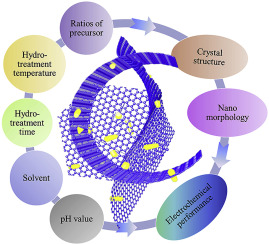当前位置:
X-MOL 学术
›
Prog. Nat. Sci. Mater. Int.
›
论文详情
Our official English website, www.x-mol.net, welcomes your
feedback! (Note: you will need to create a separate account there.)
Systematically controlled synthesis of rGO/nano-MnOx materials for supercapacitors
Progress in Natural Science: Materials International ( IF 4.8 ) Pub Date : 2019-10-01 , DOI: 10.1016/j.pnsc.2019.09.003 Xiaoyu Zhao , Haocun Yang , Yongdan Hou , Lemuel Gbologah , Liang Zhu , Yanfei Wang
Progress in Natural Science: Materials International ( IF 4.8 ) Pub Date : 2019-10-01 , DOI: 10.1016/j.pnsc.2019.09.003 Xiaoyu Zhao , Haocun Yang , Yongdan Hou , Lemuel Gbologah , Liang Zhu , Yanfei Wang

|
Abstract The effects of hydrothermal production conditions on crystal forms, morphology and electrochemical performance of in situ reduced graphene oxide/manganese oxides (rGO/MnOx) hybrid electrode materials were studied. The XRD/SEM results show that the ratio of precursors, reaction temperature and type of solvent significantly affected the crystal form obtained and nano-structure of MnOx. Varied precursor ratios of KMnO4:GO (5:1, 7:1, 9:1 and 11:1) yielded the hybrids of rGO/Mn7O135H2O, rGO/β-MnO2, rGO/Mn.98O2, and rGO/K0.27MnO2(H2O)0.54, respectively, having corresponding nano structures of nano-sheets composed petal-like shape, petal-like shape based nano-wire clusters, petal-like shape with backwardly arched top and bigger mesoporous petal-like nano structures. Hybrid prepared precursor with the ratio of 5:1 exhibited the highest specific capacitance of 320 F/g at 0.2 A/g and the smallest diffusion impedance. However, hybrid prepared precursor with the ratio of 7:1 presented the lowest electron transfer impedance. Varying hydrothermal treatment temperatures (140, 160 and 200 °C) yielded hybrids: rGO/MnO(OH), rGO/Mn0.91O1,82(H2O)0.18, and rGO/Mn7O135H2O, respectively. The nano structures of the hybrids were nano-sheets having petal-like mesoporous structure, but having larger dimensions as temperature increase. The hybrid prepared at 160 °C showed the highest specific capacitance of 214 F/g at a current density of 0.2 A/g and the lowest solution resistance of 1.61 Ω, whiles, the hybrid prepared at 140 °C inferred the best cyclic reversibility.
中文翻译:

用于超级电容器的 rGO/纳米 MnOx 材料的系统控制合成
摘要 研究了水热生产条件对原位还原氧化石墨烯/氧化锰(rGO/MnOx)杂化电极材料晶型、形貌和电化学性能的影响。XRD/SEM 结果表明,前驱体的比例、反应温度和溶剂类型显着影响了 MnOx 的晶型和纳米结构。KMnO4:GO 的不同前驱体比率(5:1、7:1、9:1 和 11:1)产生了 rGO/Mn7O135H2O、rGO/β-MnO2、rGO/Mn.98O2 和 rGO/K0.27MnO2 的混合物(H2O)0.54,分别具有相应的纳米片纳米结构,包括花瓣状、花瓣状纳米线簇、花瓣状顶部向后拱形和更大的介孔花瓣状纳米结构。混合制备的前驱体,比例为 5:图 1 在 0.2 A/g 下表现出最高的比电容 320 F/g 和最小的扩散阻抗。然而,比例为 7:1 的混合制备的前驱体表现出最低的电子转移阻抗。不同的水热处理温度(140、160 和 200 °C)产生杂化物:分别为 rGO/MnO(OH)、rGO/Mn0.91O1,82(H2O)0.18 和 rGO/Mn7O135H2O。杂化物的纳米结构是具有花瓣状介孔结构的纳米片,但随着温度的升高尺寸更大。在 160 °C 制备的杂化物在 0.2 A/g 的电流密度下显示出最高的比电容为 214 F/g,最低的溶液电阻为 1.61 Ω,而在 140°C 制备的杂化物则具有最佳的循环可逆性。比例为 7:1 的混合制备的前驱体表现出最低的电子转移阻抗。不同的水热处理温度(140、160 和 200 °C)产生杂化物:分别为 rGO/MnO(OH)、rGO/Mn0.91O1,82(H2O)0.18 和 rGO/Mn7O135H2O。杂化物的纳米结构是具有花瓣状介孔结构的纳米片,但随着温度的升高尺寸更大。在 160 °C 制备的杂化物在 0.2 A/g 的电流密度下显示出最高的比电容为 214 F/g,最低的溶液电阻为 1.61 Ω,而在 140°C 制备的杂化物推断出最好的循环可逆性。比例为 7:1 的混合制备的前驱体表现出最低的电子转移阻抗。不同的水热处理温度(140、160 和 200 °C)产生杂化物:分别为 rGO/MnO(OH)、rGO/Mn0.91O1,82(H2O)0.18 和 rGO/Mn7O135H2O。杂化物的纳米结构是具有花瓣状介孔结构的纳米片,但随着温度的升高尺寸更大。在 160 °C 制备的杂化物在 0.2 A/g 的电流密度下显示出最高的比电容为 214 F/g,最低的溶液电阻为 1.61 Ω,而在 140°C 制备的杂化物则具有最佳的循环可逆性。杂化物的纳米结构是具有花瓣状介孔结构的纳米片,但随着温度的升高尺寸更大。在 160 °C 制备的杂化物在 0.2 A/g 的电流密度下显示出最高的比电容为 214 F/g,最低的溶液电阻为 1.61 Ω,而在 140°C 制备的杂化物则具有最佳的循环可逆性。杂化物的纳米结构是具有花瓣状介孔结构的纳米片,但随着温度的升高尺寸更大。在 160 °C 制备的杂化物在 0.2 A/g 的电流密度下显示出最高的比电容为 214 F/g,最低的溶液电阻为 1.61 Ω,而在 140°C 制备的杂化物则具有最佳的循环可逆性。
更新日期:2019-10-01
中文翻译:

用于超级电容器的 rGO/纳米 MnOx 材料的系统控制合成
摘要 研究了水热生产条件对原位还原氧化石墨烯/氧化锰(rGO/MnOx)杂化电极材料晶型、形貌和电化学性能的影响。XRD/SEM 结果表明,前驱体的比例、反应温度和溶剂类型显着影响了 MnOx 的晶型和纳米结构。KMnO4:GO 的不同前驱体比率(5:1、7:1、9:1 和 11:1)产生了 rGO/Mn7O135H2O、rGO/β-MnO2、rGO/Mn.98O2 和 rGO/K0.27MnO2 的混合物(H2O)0.54,分别具有相应的纳米片纳米结构,包括花瓣状、花瓣状纳米线簇、花瓣状顶部向后拱形和更大的介孔花瓣状纳米结构。混合制备的前驱体,比例为 5:图 1 在 0.2 A/g 下表现出最高的比电容 320 F/g 和最小的扩散阻抗。然而,比例为 7:1 的混合制备的前驱体表现出最低的电子转移阻抗。不同的水热处理温度(140、160 和 200 °C)产生杂化物:分别为 rGO/MnO(OH)、rGO/Mn0.91O1,82(H2O)0.18 和 rGO/Mn7O135H2O。杂化物的纳米结构是具有花瓣状介孔结构的纳米片,但随着温度的升高尺寸更大。在 160 °C 制备的杂化物在 0.2 A/g 的电流密度下显示出最高的比电容为 214 F/g,最低的溶液电阻为 1.61 Ω,而在 140°C 制备的杂化物则具有最佳的循环可逆性。比例为 7:1 的混合制备的前驱体表现出最低的电子转移阻抗。不同的水热处理温度(140、160 和 200 °C)产生杂化物:分别为 rGO/MnO(OH)、rGO/Mn0.91O1,82(H2O)0.18 和 rGO/Mn7O135H2O。杂化物的纳米结构是具有花瓣状介孔结构的纳米片,但随着温度的升高尺寸更大。在 160 °C 制备的杂化物在 0.2 A/g 的电流密度下显示出最高的比电容为 214 F/g,最低的溶液电阻为 1.61 Ω,而在 140°C 制备的杂化物推断出最好的循环可逆性。比例为 7:1 的混合制备的前驱体表现出最低的电子转移阻抗。不同的水热处理温度(140、160 和 200 °C)产生杂化物:分别为 rGO/MnO(OH)、rGO/Mn0.91O1,82(H2O)0.18 和 rGO/Mn7O135H2O。杂化物的纳米结构是具有花瓣状介孔结构的纳米片,但随着温度的升高尺寸更大。在 160 °C 制备的杂化物在 0.2 A/g 的电流密度下显示出最高的比电容为 214 F/g,最低的溶液电阻为 1.61 Ω,而在 140°C 制备的杂化物则具有最佳的循环可逆性。杂化物的纳米结构是具有花瓣状介孔结构的纳米片,但随着温度的升高尺寸更大。在 160 °C 制备的杂化物在 0.2 A/g 的电流密度下显示出最高的比电容为 214 F/g,最低的溶液电阻为 1.61 Ω,而在 140°C 制备的杂化物则具有最佳的循环可逆性。杂化物的纳米结构是具有花瓣状介孔结构的纳米片,但随着温度的升高尺寸更大。在 160 °C 制备的杂化物在 0.2 A/g 的电流密度下显示出最高的比电容为 214 F/g,最低的溶液电阻为 1.61 Ω,而在 140°C 制备的杂化物则具有最佳的循环可逆性。











































 京公网安备 11010802027423号
京公网安备 11010802027423号